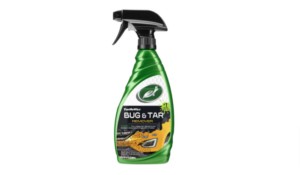Road tar is an unavoidable nuisance for car owners. Those sticky black spots, flung up from freshly paved roads, can quickly mar your car’s otherwise pristine finish. Tar is not only unsightly, but it can also be a challenge to remove, potentially damaging your car’s paint if you’re not careful. But don’t worry, getting tar off your car is entirely achievable with the right methods and products. This comprehensive guide will walk you through everything you need to know about how to safely and effectively remove tar from your car, keeping it looking its best.
Understanding Tar and Why Removal is Crucial
Tar, or asphalt, is a petroleum-based binder used in road construction, known for its incredibly sticky nature. When your car encounters fresh road surfaces, this tar can easily flick up and adhere to your vehicle’s lower panels, wheel wells, doors, and bumpers. The longer tar sits on your car, the harder it becomes to remove, baking onto the surface and potentially causing damage over time. Furthermore, tar can trap dirt and other contaminants against your car’s paint, accelerating deterioration and dulling the shine. Prompt and proper tar removal is essential to maintain your car’s appearance and protect its paintwork.
Preparation is Key: Gathering Your Tar Removal Arsenal
Before you start battling those stubborn tar spots, proper preparation will make the process smoother and more effective. Here’s what you’ll need to assemble:
- Car Wash Supplies: Car wash soap, a wash bucket, warm water, and a wash mitt or sponge are crucial for pre-cleaning and post-cleaning.
- Microfiber Cloths: Stock up on high-quality microfiber cloths. These are essential for gentle and effective tar removal without scratching your paint.
- Tar Removal Product: Choose your preferred method. Options include dedicated tar removers, WD-40, Goo Gone, or even household peanut butter.
- Cool, Shaded Workspace: Work in a shaded area or your garage. Direct sunlight and heat can cause cleaning products to dry too quickly and make tar removal more difficult.
Turtle Wax Bug and Tar Remover Spray for effective car cleaning.
Step-by-Step Guide to Removing Tar from Your Car
Follow these steps for a safe and successful tar removal process:
- Wash Your Car First: Begin with a thorough car wash. This removes loose dirt and debris that could scratch your paint during tar removal. Ensure the car is completely dry before proceeding.
- Identify Tar Spots: Carefully inspect your car to pinpoint all areas affected by tar. Pay close attention to lower panels, wheel wells, rocker panels, and bumpers, as these are the most vulnerable areas.
- Apply Your Chosen Tar Remover:
- Dedicated Tar Remover: These are specifically formulated to dissolve tar safely. Bug and tar remover products are readily available at auto parts stores like AutoZone. Apply the product directly to the tar spots, following the manufacturer’s instructions for dwell time.
- WD-40: Spray WD-40 onto a microfiber cloth and gently dab it onto the tar. Let it sit for 10-30 minutes to allow the solvent to break down the tar.
- Goo Gone: Apply Goo Gone liberally to the tar spots and let it sit for a few minutes. The citrus oils will help loosen the tar’s grip.
- Peanut Butter (Yes, Really!): Smear a small amount of creamy peanut butter onto the tar. The oils in peanut butter can help dissolve tar. Let it sit for a few minutes.
- Gently Wipe Away the Tar: Using a clean microfiber cloth, gently wipe the treated tar spots. Avoid excessive pressure, as you want to lift the tar off, not scratch the paint. For stubborn spots, you may need to repeat the application and wiping process.
- Wash the Area Again: After removing the tar, wash the treated areas with car wash soap and water to remove any residue from the tar remover. This is crucial to prevent any potential damage or discoloration from the cleaning product.
- Dry and Inspect: Dry the area with a clean microfiber cloth and inspect for any remaining tar. If needed, repeat the process for any lingering spots.
- Wax Your Car: Tar removal products can strip away wax. To protect your paint and restore shine, apply a fresh coat of car wax to the treated areas.
Close-up of soft microfiber cloths essential for car cleaning and tar removal.
Choosing the Right Tar Removal Method
Several effective methods exist for tar removal, and the best choice often depends on personal preference and the severity of the tar buildup.
- Dedicated Tar Removers: These are often considered the most effective and safest option. They are specifically designed for automotive paint and contain chemicals that break down tar without harming the clear coat. Brands like Turtle Wax and Mothers offer popular and reliable bug and tar remover sprays.
- WD-40: A readily available household product, WD-40 works as a tar remover due to its solvent properties. It’s effective for dissolving tar, but it’s important to wash off the residue thoroughly afterward to prevent it from affecting your car’s paint or wax.
- Goo Gone: This citrus-based cleaner is a gentler alternative, effective for removing tar without harsh chemicals. It’s a good option for those concerned about using strong solvents on their car’s paint.
- Peanut Butter: While it sounds unconventional, peanut butter can work in a pinch. The oils in peanut butter help to soften and lift tar. However, it can be messy and may require more effort to remove the residue.
- Decontamination Soap (Professional Grade): For heavy tar contamination, professional detailers use specialized decontamination soaps. These are highly effective but generally require professional application.
Soft wash mitt for safe and effective car cleaning before and after tar removal.
Essential Tips for Safe and Efficient Tar Removal
- Always Start with a Clean Car: Washing your car before tar removal is non-negotiable. Dirt particles can act as abrasives and cause scratches when you wipe.
- Test in an Inconspicuous Area: Before applying any tar remover to a visible area, test it on a hidden spot, like inside a door jamb or low on a rocker panel, to ensure it doesn’t damage or discolor your paint.
- Be Patient and Gentle: Tar removal takes time and patience. Avoid rushing or using excessive force, which can lead to scratches. Gentle, repeated applications are more effective than aggressive scrubbing.
- Re-Wax After Tar Removal: Most tar removal methods will strip away your car’s wax. Protect your newly cleaned paint by applying a fresh coat of car wax after removing tar. This will also make future tar removal easier.
- Consider Professional Detailing: For extensive or stubborn tar contamination, consider seeking professional car detailing services. Detailers have specialized tools and products to handle challenging tar removal safely.
Preventing Tar Build-Up in the Future
Prevention is always better than cure. Here are a few tips to minimize tar build-up on your car:
- Regular Car Washing: Frequent car washes, especially after driving on newly paved roads, can prevent tar from bonding strongly to your car’s paint.
- Wax or Ceramic Coating: A good coat of wax or a ceramic coating provides a protective barrier that makes it harder for tar to stick and easier to remove.
- Mud Flaps: Installing mud flaps, especially on the front wheels, can significantly reduce the amount of road debris, including tar, that gets splashed onto your car’s sides.
- Avoid Freshly Paved Roads: When possible, avoid driving on roads that have just been paved, as these are the primary source of tar splatter.
Frequently Asked Questions About Tar Removal
Q: Will tar remover damage car paint?
A: When used correctly, dedicated tar removers designed for cars are safe for automotive paint. However, always test in an inconspicuous area first and follow product instructions. Harsh chemicals or excessive scrubbing can potentially damage the clear coat.
Q: Can I use household cleaners to remove tar?
A: It’s best to avoid most household cleaners, as they may be too harsh and damage your car’s paint. Stick to products specifically designed for car care or proven safe alternatives like WD-40 or Goo Gone, used with caution.
Q: How often should I remove tar from my car?
A: Remove tar as soon as you notice it. The longer it sits, the harder it becomes to remove and the greater the potential for damage. Regular car washing and waxing will help prevent significant tar buildup.
Q: Can tar be removed from plastic car parts?
A: Yes, tar can be removed from plastic car parts using the same methods as paint. However, always test your chosen product in an inconspicuous area of the plastic first to ensure it doesn’t cause discoloration or damage.
Q: Where can I buy tar removal products?
A: You can find a wide range of tar removal products at AutoZone, along with other car cleaning and detailing supplies.
By following this guide and taking a proactive approach, you can effectively remove tar from your car and keep it looking its best for years to come. Remember, patience and the right products are your best allies in the fight against road tar!


